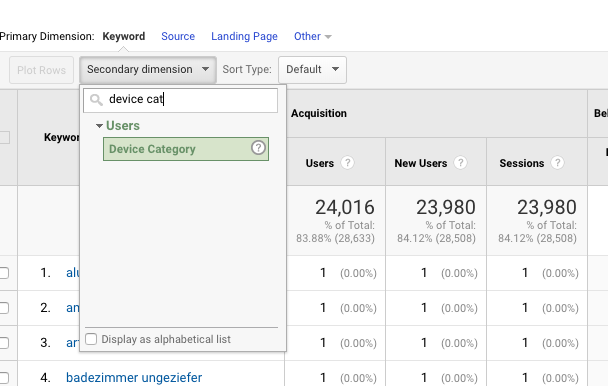Enhance Your Information Analysis Using Additional Dimension in Google Analytics
Discovering the abilities of additional measurements in Google Analytics opens a world of opportunities for refining data evaluation. The ability to dissect info better beyond the surface level provides a nuanced sight that can form tactical decisions. By layering additional measurements onto main information collections, a more elaborate narrative emerges, losing light on customer interactions and performance indications. This vibrant method to information assessment holds the key to unlocking covert patterns and patterns that might transform exactly how organizations interpret their digital impact.
Recognizing Second Measurements
In the realm of data evaluation, a critical element to understanding is the concept of additional dimensions and their value in extracting deeper insights from Google Analytics records. Secondary dimensions in Google Analytics describe additional parameters that can be included to the key measurement, permitting a much more thorough evaluation of data. By integrating second measurements, analysts can segment and filter data to reveal patterns, fads, and connections that might not appear when checking out the information all at once. These secondary dimensions can supply context and a more comprehensive understanding of individual actions, traffic sources, and various other key metrics tracked by Google Analytics.

Advantages of Making Use Of Secondary Measurements
When assessing information in Google Analytics, the use of second measurements uses invaluable understandings right into user actions and efficiency metrics. By including an additional dimension to your main data, you can delve much deeper right into the characteristics of your internet site visitors and their communications. One of the key advantages of making use of secondary measurements is the capacity to section and contrast information better. This division allows you to recognize exactly how various variables, such as demographics or web traffic resources, impact individual habits and conversions (Secondary Dimension in Google Analytics).
In addition, secondary measurements enhance the context of your key information, offering a much more thorough sight of individual involvement and efficiency metrics. On the whole, the usage of additional dimensions in Google Analytics can dramatically boost the depth and high quality of your information analysis, leading to more enlightened decision-making and boosted results.
Exactly How to Include Second Measurements
By including secondary dimensions in Google Analytics, customers can acquire much deeper understandings into their data evaluation procedure, permitting for more thorough analysis of customer habits and performance metrics. Including additional dimensions is an uncomplicated process that can considerably boost the depth of analysis. As soon as in the report, find the "Additional measurement" tab above the data table.
Studying Data With Second Measurements
Making use of additional dimensions in information analysis provides a more comprehensive understanding of user habits and efficiency metrics. By adding an additional measurement to your main information set in read here Google Analytics, you can dig much deeper into the qualities of your internet site site visitors and their communications. For circumstances, integrating the key measurement of 'source/medium' with the additional dimension of 'landing web page' can disclose which specific web pages are attracting website traffic from various resources, aiding you optimize these pages for much better engagement.

Fundamentally, analyzing data with second measurements empowers you to gain valuable understandings into individual actions, recognize patterns, and make informed choices to enhance the performance of your electronic residential or commercial properties.
Finest Practices for Secondary Dimensions
In information analysis, including additional dimensions effectively can considerably enhance the deepness of insights acquired from metrics and user behavior patterns. When using secondary measurements in Google Analytics or any other logical device, it is critical to abide by finest techniques to ensure the precision and relevance of the information analysis.
One secret best practice is to thoroughly select additional measurements that complement the main dimension being analyzed. Selecting second measurements that give additional context or additional division can supply a much more extensive understanding of the data. It is additionally essential to stay clear of overcomplicating the evaluation by consisting of also many additional dimensions, which may cause complication or dilution of understandings.
Moreover, it is advisable to experiment with different combinations of main and second measurements to reveal new correlations and trends. Regularly reviewing and improving the choice of second measurements based upon the certain objectives of the analysis can lead to even more workable insights. By adhering to these ideal techniques, information analysts can utilize second measurements properly to boost the overall data analysis process and decision-making capabilities.

Conclusion
To conclude, integrating second dimensions in Google Analytics is vital for an extensive data analysis technique. By leveraging second measurements together with main ones, experts and marketing experts can reveal useful understandings and relationships that can educate decision-making and enhance digital marketing techniques. Understanding just how to read the article properly utilize second check this measurements and complying with best techniques will enable professionals to remove significant data and enhance their overall efficiency metrics.
Secondary measurements in Google Analytics refer to added specifications that can be added to the main dimension, permitting for a more comprehensive evaluation of information. By including additional measurements, experts can segment and filter information to reveal patterns, trends, and correlations that could not be evident when looking at the information as a whole. Combining the key dimension of 'source/medium' with the secondary dimension of 'touchdown page' can disclose which particular web pages are attracting website traffic from different resources, helping you optimize these pages for much better engagement.
One secret ideal practice is to meticulously select additional measurements that match the primary measurement being analyzed. By complying with these ideal methods, data analysts can take advantage of second dimensions successfully to enhance the total information analysis process and decision-making capacities.